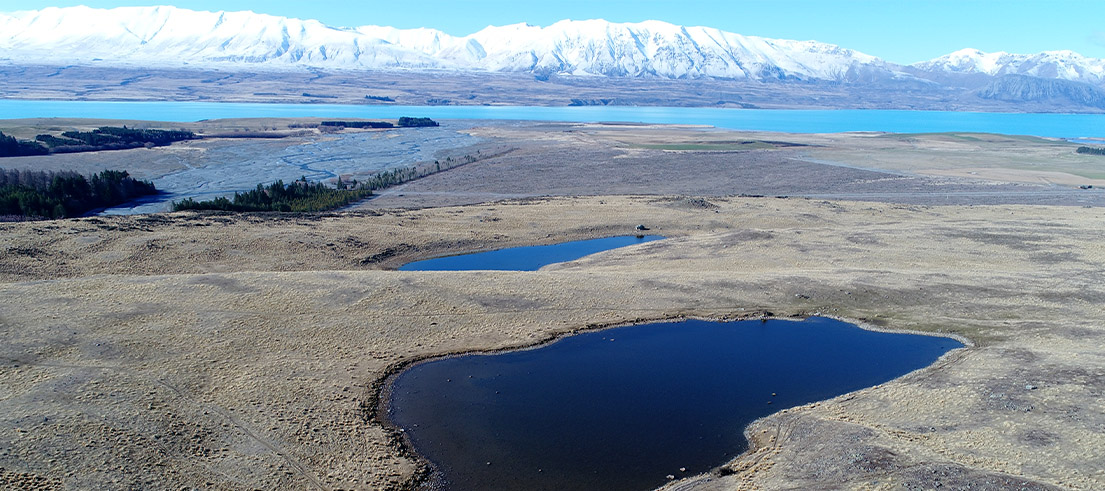
Upper Waitaki environmental projects secure $95,000 boost
Six local projects have been recommended for nearly $95,000 in funding to protect environmental values in the Upper Waitaki.
Funding of $94,911 was recommended by the Upper Waitaki Water Zone Committee at their meeting on Friday 18 September in Otematata.
Six projects approved for funding
The six projects involve bog pine protection, fencing of tarns, native planting, weed control and wetland protection on four stations in the zone.
- The Quailburn bog pine protection project has been recommended for $17,600 to go towards fencing off an area of bog pine (a rare naturally-occurring ecosystem) on Quailburn Station adjacent to the Ben Dhu scientific reserve.
- The Glenmore Station Tarns project has been recommended for $7,400 to be put towards fencing off precious tarns on the station, ecologically significant parts of the rural environment.

Balmoral wetland near Takapō
- The Upper Ōhau weed control project has been recommended for $30,000 to remove invasive weeds that threaten the habitat of native species.
- The Balmoral wetland protection project has been recommended for $24,400 to fence a total of 3850m around two tarns and a large wetland, protecting the high biodiversity values and native species living in the waterways.
- Lake Alexandrina Conservation Trust Native Planting will receive $4,600 for native planting of West Creek near Lake Alexandrina.
- A willow control project has been approved in principle for $7,000 but details are still to be finalised.
See below for a more detailed breakdown of each project and its funding.
Funding to support costly fencing projects

Stoney Tarn on Glenmore Station
Fencing vast, often mountainous terrain in the backcountry of South Canterbury’s stations is particularly challenging and costly to erect and maintain.
The Upper Waitaki zone is the largest water catchment in Canterbury and fencing is expensive – hence the need for financial assistance from the Immediate Steps programme.
Chair of the Upper Waitaki Water Zone Committee, Simon Cameron, said:
"The committee is impressed with these projects, which will benefit the local environment, particularly the level of collaboration involved from many different parties.
"We look forward to hearing back from staff about how the projects progress in the future."
Protection of habitat a priority
Supporting new projects that protect and enhance biodiversity is important to the Upper Waitaki Water Zone Committee.
Protecting the biodiversity of the zone’s water bodies is one of the outcomes created by the zone committee as a top priority under their Upper Waitaki ZIP Addendum (PDF File, 2.06MB).
More about the projects
The Upper Waitaki Water Zone Committee has recommended funding of $17,600 to help protect a unique block of bog pine (Halocarpus bidwillii) from grazing sheep with the addition of new 1.7km fence. The landowner will also be contributing to the project.
The area put forward for protection is a naturally uncommon ecosystem and, as well as the native bog pine, also provides habitat for threatened sub-alpine flora - Lepidium solandri (Threatened - Nationally endangered) and Carmichaelia crassicalis - (At risk - declining).
Lepidum solandri is a small native peppercress in the Brassicaceae family. Its visually ‘uninteresting’ appearance is partly to blame for the low awareness around its conservation plight. In contrast, the Carmichaelia crassicalis has beautiful pale pink and purple flowers, but also is facing decline due to reduction of habitat.
The bog pine block to be protected sits beside the Department of Conservation’s Ben Dhu scientific reserve, which is already well-fenced from stock to stop the small plants from being damaged or trampled.
Immediate Steps funding was approved in August 2018 for fencing lakes and tarns on Glenmore Station, including Lake Alexandrina, Lake Murray and Stoney, Tui and Grebe Tarns. The additional funding will now contribute to 2.5km of fencing for two further unnamed tarns.
Fencing these lakes and tarns will protect water quality, improve the habitat and also reduce impact on native bird species such as the kakī.
In addition to the fencing, the tarn and lake protection project has also collaborated with the QEII National Trust to place land protection covenants on Lake Murray, Stoney and Tui Tarns, as well as the unnamed tarns.
The project, which has been ongoing since 2019, targets the invasive weeds that threaten the habitat of native species.
Most pressing for control is the crack willow and Russell lupin. Crack willow, in particular, colonises wetlands and braided rivers, changing the hydrology and dominating existing native vegetation in wetlands.
Other targeted species include buddleia, alder, elderberry, cotoneaster, gooseberry, flowering currant, raspberry and hops.
Department of Conservation, Land Information New Zealand and Glen Lyon will continue to be involved in the project in 2020-2021 with large-scale weed control to continue over this catchment.
The wetland, called Old Man Swamp, is a large, diverse wetland that supports a wide variety of vegetation communities, including Carex sedgeland, bog rush tussockland, red tussock grassland and small areas of comb sedge cushion fields, and shallow open water. The wetland is an important mahinga kai resource and holds a few species of importance, such as Ranunculus brevis and supports many native birds.
Swan Lagoon and an unnamed tarn will also be protected with fencing. These tarns support species such as Kaki, black-fronted tern, banded dotterel, New Zealand pipit, New Zealand Pied oystercatcher and black shag
Tarns in this area are significant and hold many tiny plant species that only grow in the microclimates that the tarns support, including Hypericum rubicundulum (Threatened - Nationally Endangered) and Carex rubicunda (Threatened - Nationally Vulnerable).
The $4,600 funding will cover costs of the plants and materials needed for planting and the volunteers will carry out the work and maintenance.
Feature image: two unnamed tarns at Glenmore Station will be protected as part of the funding.
